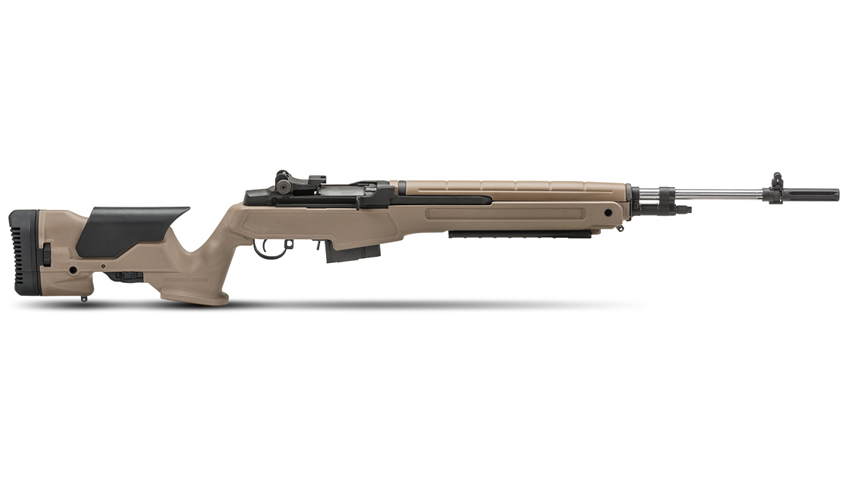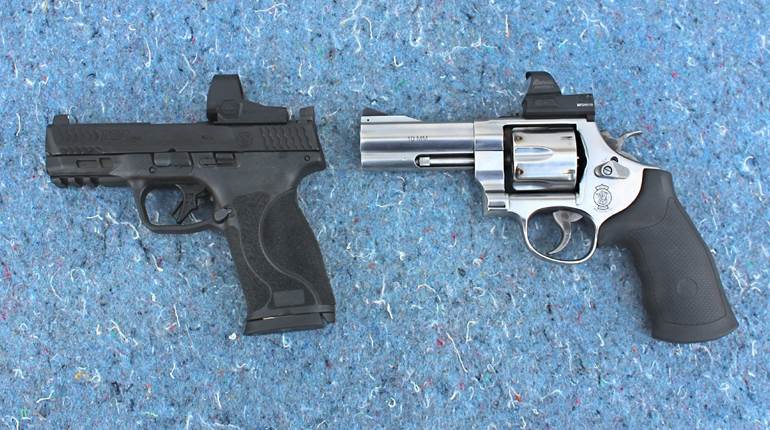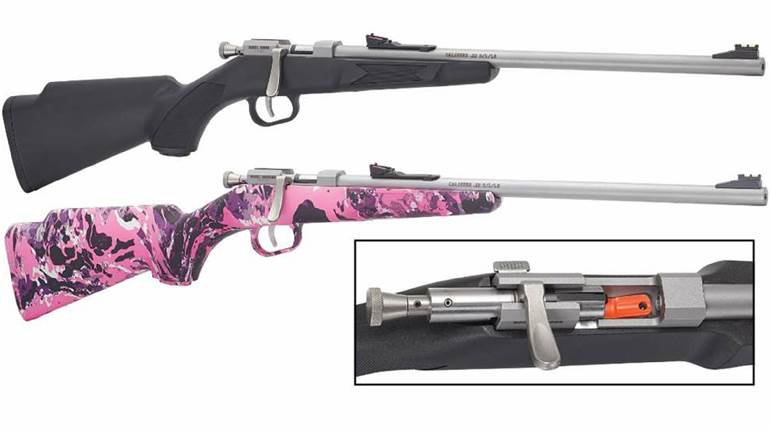
Back when our grandparents went shopping for firearms, they were greeted by rifle racks filled with fine blued steels and handcrafted hardwood stocks. Prior to World War II, a rifle shipped with a wooden stock. But just as every other facet of the shooting sports has been affected by technological advances, rifle stocks too have continued to change and evolve with the introduction of new materials and manufacturing processes. Today you'll find rifles outfitted with shock-resistant polymers, multi-layered composites and milled-metallic chassis systems standing right alongside the natural hardwood models.
If you've recently arrived on the shooting-sports scene, then a better understanding of the perks and limitations of various stock materials can be helpful when deciding which rifle to buy. Delving deeply into stock options would require an encyclopedic level of historical and scientific information, so this article is by no means all inclusive. Instead, this is a high-level introduction to the most common stock-material categories you’re likely to see displayed on your local dealers’ shelves.
Natural Hardwood Stocks
For some rifle enthusiasts, there will never be a stock material that is a suitable replacement for a properly crafted piece of hardwood, lovingly shaped to support the rifle's action, caress the shooter's hands and please the owner's eyes. Although walnut is a staple of the stock business, other durable woods including birch (often stained to look like walnut), maple and mesquite are used as well.
There's a whole nomenclature dedicated to describing wood stocks that includes vocabulary such as grain, figure and grade. A piece of wood is rejected for use as a stock if it has weaknesses or flaws that will cause it to fracture from the stresses induced by gunfire. Thus the reliability of the wood is a starting point for pricing since a piece of wood does not have to be pretty to do the job. The more beautiful the piece of wood, the more expensive it’s going to be.

Henry Repeating Arms Fancy Stock Upgrade
Properly cared for, natural wood stocks will last multiple lifetimes, but they do have their weaknesses. Like other nature-made products, wood is susceptible to changes in humidity and water damage. It’s relatively easy to ding and scratch hardwoods, taking away from their inherent beauty, and despite the best efforts of craftsmen to pick suitable sticks to work with, wood stocks can still crack or fracture-even with moderate use.
In the mid 1990s, I remember a fellow sporting-goods store employee lamenting the disappearance of hardwood stocks due to ever shrinking old-growth forest products to draw from. His timing was off (they should all be gone by now), but he was right in that wood prices have continued to increase and more long guns now leave the factory outfitted with polymer. But as long as there are enthusiasts who want the warmth and good looks that hardwood provides, these stocks are unlikely to disappear completely.
Laminated Hardwood Stocks
The use of laminated wood for gun stocks goes back to around World War II, when the Germans installed them on the Mauser 98. If you crack open a dictionary, it will say that a laminate is a hard, flat or flexible substance formed of thin layers of material that have been fixed together with adhesives or resins. In the case of laminated hardwood rifle stocks, the engineered laminated wood is stronger, up to 50 percent stiffer and is far more water resistant than natural hardwoods.

Boyds Featherweight Thumbhole hunting stock (Top) and At-One target stock (Bottom)
Without revealing any industrial secrets, I can say that resins are layered with thin sheets of hardwood to form what is called a "blank." The blank is then subjected to heat and pressure which infuses the wood fibers with the resins at a microscopic level. The resin acts as an adhesive, stiffener and waterproofing agent. Once cured, the resin can be cut, shaped and sanded just like the wood to which it’s bonded. Using wood layers that have been stained in different colors allows the manufacturer to produce grain patterns that are subtle and subdued or brightly eye catching.
In essence, wood laminates split the difference between natural wood and polymer stocks. You get the warmth and feel of wood, with the increased stiffness and waterproofing provided by the resins. If the only examples of laminated stocks you've seen are the poorly executed plywood-like examples found on surplus military guns (AKs, Mosin Nagants, SKS), then you may not be overly impressed with this stock material's appearance. However, those companies that apply the skills, take the time and use the quality materials needed to get it right produce handsome, handy and durable stocks.
Polymer Stocks
Remington Arms made history in 1958 by launching the first commercially produced rifle with polymer stocks. Taking advantage of the company's relationship with DuPont, the Nylon 66 rimfire rifle featured Nylon Zytel-101 components, a material which is part of the Nylon 66 family of plastics.

Remington Nylon 66
Polymer rifle stocks have become the workhorse of the industry. The motivations for developing them more than 60 years ago are the same as they are today, namely, reduced production costs. The stocks are formed by injecting molten polymer into industrial molds which can be precisely manufactured using CNC technology. The interior of these molds can be designed to accomplish detailed work that would otherwise have to be done by hand, such as molding in checkered gripping surfaces, ports and trigger guards, to name a few. In some cases, key metallic supports and components (aluminum bedding blocks, screw ports, etc.) are set into the molds ahead of the injection process so that the stock comes out of the mold with these parts in place. Once out of the mold, polymer stocks need very little hands-on attention in order to be ready for installation.
Thanks to continuing advancements in material sciences and engineering, well-made polymer stocks are lightweight, durable and waterproof. Some stocks are reinforced with fibrous materials, like fiberglass, to make them stiffer and stronger. Polymers do get dinged and scratched in the field like other stock materials. But because the polymer material is consistent throughout, the damage is not as noticeable. Basic models are among the least expensive stock options available. Although they can be found in a variety of colors; black, olive drab and flat-dark-earth tend to be the most common options for sporting purposes.

Savage Arms 11/110 Hog Hunter
Do all of these positive polymer qualities make it the end-all-be-all of modern stock materials? Not exactly. While there are varying grades of polymer stocks (high quality, mid grade, low grade), it seems like the majority of them are made to utilitarian, good-enough-to-get-by standards. They're not all that pretty to look at and visible mold marks are not uncommon. Lower quality polymers can be too soft, taking more dings and scratches, or too brittle with a tendency to crack. In some cases, the barrel bedding area can be crooked which in turn can affect accuracy by applying more pressure to one side of the barrel than the other.
As with any other rifle component, those manufactured by well-trusted companies are going to produce the best long term results.
Composite Stocks
As the name implies, composite stocks combine a variety of materials in order to provide a desirable set of features. One of the top priorities is often to reduce the stock's weight, while making it stiff for improved accuracy and durable for regular use or tough field conditions.

McMillan F-Class Custom Fiberglass Competition Model
This is another stock option that is assembled via a lamination process using molds. The interior of the two halves of the stock's mold are layered with binding resins and fibrous materials including fiberglass, Kevlar and carbon fiber (in some cases a blend of all three). These fibers are much lighter than the hardwoods used in wood laminates. There is a great deal of latitude at this point in the process for customization in regards to surface textures and color schemes.
Once the laminated outer shells of the stock are complete, the two halves are pressed together to form a single, hollow unit. The interior of the shell is then hand packed or injected with a dense polyurethane foam material (comparable to the cores of modern surfboards) to fill in the empty spaces. At some point in the process (it depends on the manufacturer), metallic mounting points and aluminum bedding blocks are attached to support the action. The stock is then sanded down, outfitted with the ordered accessories and polished up before shipping.
Composite stocks are rigid, strong and precisely fitted to the rifle's action. They are highly favored by military snipers, competition shooters and hunters looking to reduce the weight of their rifles as much as possible. Simply put, composite stocks are among the best options available. However, composite stocks are labor intensive and require more expertise to complete. As a result, they are among the most expensive stocks available.
Modular Chassis Systems
Once relegated to military and competition applications, aluminum chassis systems have made serious inroads into the civilian shooting market over the last few years. This style of stock is commonly attached to long-range precision bolt guns in order to give the rifle that familiar feel and modularity often associated with AR/MSR type semi-automatic platforms.

Brownells MDT BRN-1 Stripped Chassis
At the heart of this stock system is a one-piece, milled aluminum chassis that supports the rifle's action and provides connection points for AR-type pistol grips and shoulder stocks. The hand guard does not touch the barrel, known as “free floating,” for improved accuracy. Usually the hand guard extension is vented to reduce weight and features AR accessory slots (M-LOK, KeyMod) along with sling attachment points. The magazine well accepts removable box magazines (often replacing a smaller capacity fixed magazine) for faster reloading. AR-15 pistol grips are plentiful and available in a wide variety of utilitarian and target models. Depending on the chassis configuration, it can be outfitted with fixed, folding or telescopic shoulder stocks.

Howa 1500 Bolt-Action with BRN-1 Chassis
Chassis systems have several advantages. They are extremely simple to install and upgrade. The aluminum chassis is durable and supports tactical accessories (lasers, lights) that other stocks do not. Stocks and grips can be swapped out quickly and easily. However, they are not the lightest stocks available (the system shown here adds one pound of weight compared to a wood stock). Adding tactical accessories will weigh them down even more. Due to the materials and machining involved, they are among the more expensive stocks. But for those who prefer the feel and familiarity of an AR/MSR when shooting a bolt action, they're hard to beat.
Learn more about the products mentioned in this article:
Tested: Springfield Armory Loaded M1A
Field Tested: Henry Lever-Action Fancy Stock Sets
Boyds Hardwood Stocks
Throwback Thursday: The Remington Nylon 66
Emergency Preparedness for Beginners: A Bolt-Action Rifle?
Brownells MDT BRN-1 Chassis System
















![Auto[47]](/media/121jogez/auto-47.jpg?anchor=center&mode=crop&width=770&height=430&rnd=134090788010670000&quality=60)



















